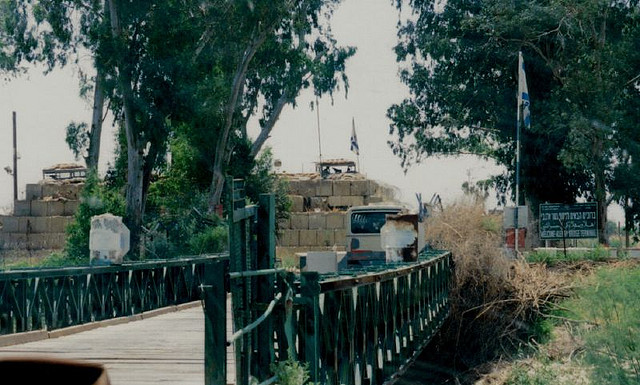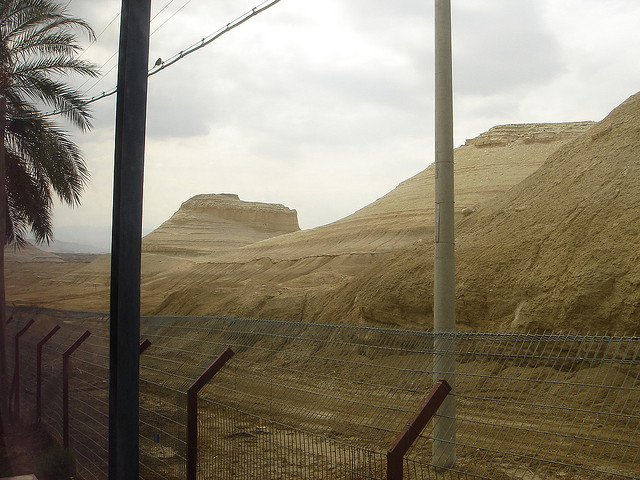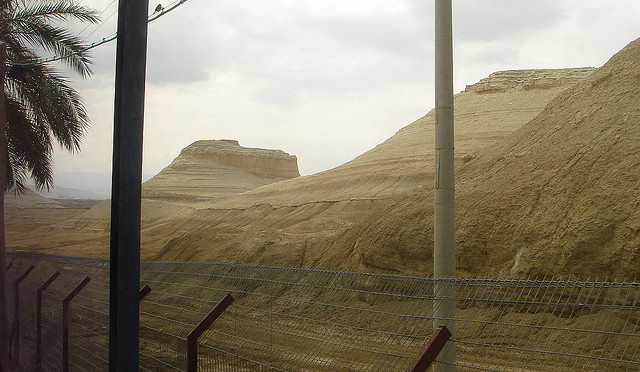The day after our trip to Jerash, we said goodbye to Jordan and set out for Israel. Readers of this blog may recall that we crossed the border into Israel once already on this trip … and that our first excursion into Israel took less than an hour. This time, we were doing more than just transiting through – we were on our way to Jerusalem.
We planned to travel overland from Amman to Jerusalem via the King Hussein Bridge (or, as it is known on the Israeli side of the border, the Allenby Bridge), which spans the Jordan River.

Everything that we had read about this border crossing indicated it was busy and intense, and so we did our best to prepare ourselves for what we anticipated being a long, potentially frustrating day. We made sure our papers were in order, that anything that might look suspicious to immigration authorities (the guidebooks which attracted the attention of the border guards on our first trip across Israel, the jar of peanut butter that we carry to keep us fed on long bus rides) was near the top of our bags and thus easily accessible for inspection, and that we were armed with plenty of snacks, water, and patience.
As there are limited departure times for public transportation to the border, we had arranged for a shared ride through a nearby hotel.1 Just after sunrise, we hopped into a minivan with a handful of other passengers and headed off towards Israel. As we descended out of the mountains surrounding Amman into the Jordan Valley, our ears popped as we caught our first glimpse of the Dead Sea off in the distance. Arriving at the Jordanian side of the border, we queued up to get our passports stamped and exit fees paid, and then boarded a large bus to drive us across the bridge.
Although we are no strangers to walking over land borders (see, e.g., that time we walked past an elephant and into Botswana, that time we had a chat with the bungee jump operator as we walked across Victoria Falls Bridge into Zimbabwe, that time we walked across the Songwe River with our Finnish and Scottish friends into Tanzania, and that time we walked more than a kilometer along a dusty road and over Rusomo Falls into Rwanda), that was not an option here. Our passports, which had been collected by the Jordanian border officials, were only returned to us once we were on board the bus and it had begun moving towards the bridge.

All of this seemed like a lot of nonsense to me,2 but I soon understood why the bus system was necessary (aside from the obvious security concerns attendant to border crossings). Our bus did not simply drive us to the other border post and drop us off; rather, it waited patiently in a line of other buses for at least an hour.
I assumed passengers on the buses ahead of us were being slow to disembark and gather their belongings. As we got closer to the border post, however, I realized that the buses formed a necessary extension of the queue. There were so many people waiting to cross the border that, had groups of people not been kept in a holding pattern on their buses, it would have been absolute pandemonium. Moreover, the longer we idled, the gladder we were to have an air conditioned seat to escape from the building midmorning heat.
Once it was time for us to disembark from our bus, we joined a fly-infested queue of people that snaked back and forth outdoors in front of the Israeli border post. Eventually, a border official tagged our big packs and relieved us of them (which was something of a feat, as we had to navigate an area choked with people and trolleys piled high with luggage to reach the drop-off point), and then began to make our way through the gauntlet of passport inspectors.3
We were still outdoors when we encountered our first set of passport inspectors, who affixed stickers to the outsides of our passports. We then moved indoors and lined up for another set of passport inspectors. This time, I was pulled aside and told to wait. Someone then inspected my backpack (my small backpack, not the one that I had “checked”) with one of those explosive detecting paper swabs. She was incredibly thorough – not even my toothbrush was spared!
Once it was determined that I was not a threat (just an American tourist who had been traveling for seven months), we were allowed to move onto a third level of passport inspection. After that, we joined another queue, cleared a final check of our passports, and were finally reunited with our luggage.
After that, it was pretty smooth sailing. We purchased tickets for a minibus that, curiously, drove us to a different minibus, and then onto Jerusalem. Given our expectations before setting out that morning, we were pleasantly surprised with how smoothly and quickly everything had gone.
1 The folks at the Jordan Tower Hotel were extremely friendly and helpful in arranging transportation.
2 A lot of nonsense designed to squeeze a few extra Jordanian dinars out of us for a mandatory bus ride over the span between the Jordanian and Israeli border posts.
3 The King Hussein Bridge – the only point of entry and exit for Palestinians crossing between Israel and Jordan – is busy on a typical day. On the day we made this crossing, the border was even busier (read: more chaotic) than normal. As we foreshadowed in our Amman post, the Hajj had just concluded, and a large number of Palestinian pilgrims were crossing back into the West Bank, after transiting through Jordan on their way back from Saudi Arabia.


